THE ETERNAL CITY?
Due to faster than expected sea level rise, scientists project that even the drastic intervention of the M.O.S.E. sea barrier project will only delay the permanent flooding of Venice by 100 to 200 years. In this future vision of drastically altered climate conditions, coastal cities such as Venice will have to physically and economically reinvent themselves in order to survive.
After the M.O.S.E. sea gates stop functioning, Venice will once again face imminent danger. Concurrently, sewage pollution will increase exponentially because the sea barrier will increasingly close the lagoon which will no longer be renewed by the tides. Venice has never maintained a main sewage system- for this reason, a large portion of the wastes generated in the historic center of Venice have always been discharge directly into its channels. Water quality, particularly near the city, is extremely poor.
Although Venice has a thriving tourism based economy, the city is becoming mummified, a static image of itself. The future of the industrial areas inland with their dying petrochemical industry grows ever weaker, while Venice itself is continually losing inhabitants. The future is a complex dynamic of environmental pressures and economic imperatives.
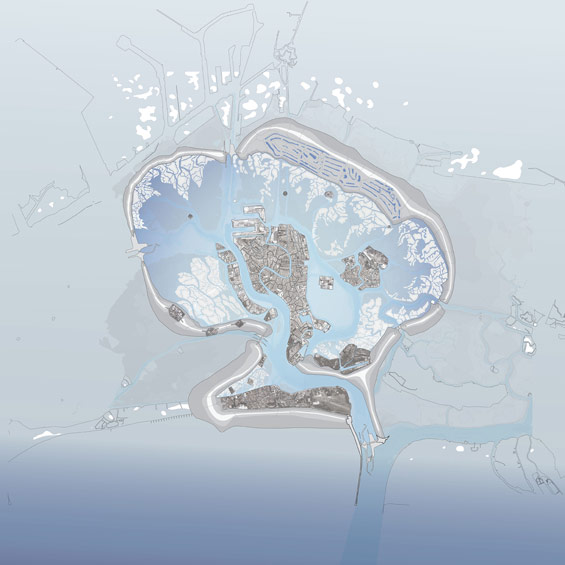
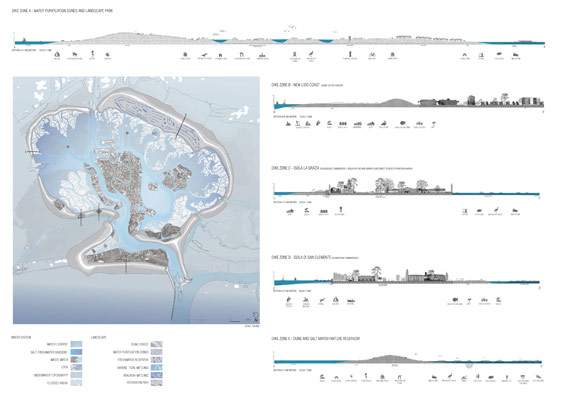
AN EMERALD BELT: LONGTERM PROTECTION FROM CLIMATE CHANGE
The Serenissima plan proposes to augment the existing underwater topography of the lagoon with a readily available and sustainable material: sand from the floor of the Adriatic. The sand is gathered by large boats called Trailing Suction Hopper Dredgers. The sand is projected into the lagoon shallows, progressively forming a dune barrier with an inner zone of sand flats and tidal marshes. This process is similar to the coastal reinforcement and climate proofing strategies of Northern Europe, for example in The Netherlands.
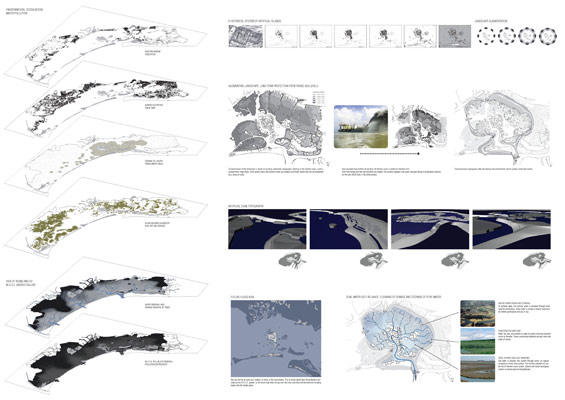
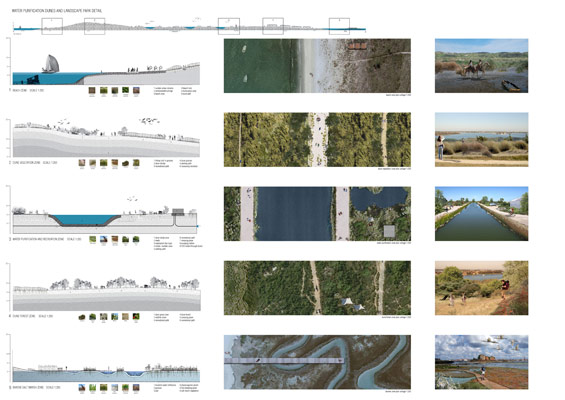
A system of locks connects the dune sections, allowing ships into the city. Opening the locks allows fresh sea water into the heart of the city, flushing water outwards into the tidal marshlands on the edges of the dune zones. The large surface area of these wetlands, which contain a gradient of salt to brackish water, is sufficient to cleanse the water. Organic waste is turned into plant biomass, which also functions as a large-scale carbon sink, thus working against climate change. Wetlands are considered the most biologically diverse of all ecosystems; they are biological engines that can be adapted to waste water treatment as well as agricultural purposes. They are vital to the large populations of migrating birds that visit the lagoon. This will in effect create an enormous nature reserve around the city and preserve the specificity of the lagoon environment.

The widest dune section functions as a water purification plant. Water is pumped through the dunes, the sand acts as a filter. Lightly brackish water can further be purified to provide fresh water and stored in reservoirs. Recreational paths, camping sites, wildlife zones, Mediterranean maquis scrubland and dune vegetation ecotopes are some of the essential elements that inform the program of the dune barrier.
This designed land will function as a hybrid territory of landscape identities and new urban growth. Residential and business zones set into the emerald necklace will create a thriving future city, with the jewel of old Venice at its heart. The edge of the city will extend to the dunes and beaches facing the New Adriatic. Finally impervious to the elements and transformed into a new island nation, Venice will once more be married to the sea.
Serenissima | Venice Italy | Jacques Abelma
Images and text Credit | Jacques Abelman.

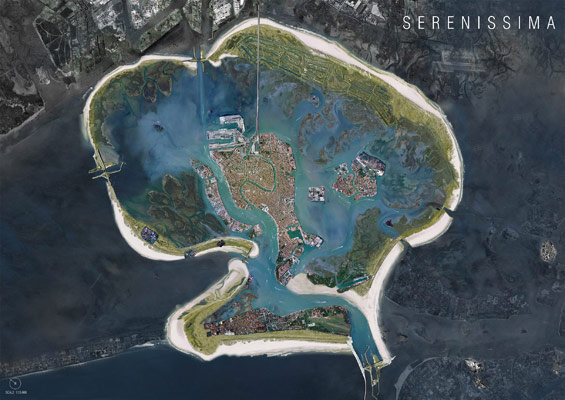

Barene are terrestrial of form to tab typical of the lagoons, periodically submerged by the tides. The name “barena” derives from the word Venetian cheater that points out a bush or a lock of grass.
Barene cover a notable surface of the lagoon in Venice.
Lagoon surface covered by barene in the 1912: 158 kmq
In the 1930: 104 kmq
In the 2003: 47 kmq
Annual loss of sediment: around 800.000 mc
(Source L.Of Alpaos 2010)
Barene are important from the ecological point of view: they contribute to favor the water exchange, they moderate the action of the wavy motion, they entertain, as already said, a characteristic vegetation and a rich avifauna. Today,nevertheless, they slowly have the tendency to disappear because eroded by the action of the waters, accelerated by human modifications. Already if ships didn’t enter in lagoon, the problems would reduced a lot.
Relatively to the system of barene that the lagoon in Venice forms them, to my opinion,they must not be touched for preserving the delicate equilibrium that he is trying to recover. I believe that the ships must not enter lagoon: it is surely beautiful for the passengers to have this sight entering and going out to Venice, but the wavy motion provoked by these, as also from motorboats and yacht, hands to the destruction of that that stays of this ecosystem.
If however they had to still be reduced, would be put to serious risk the whole lagoon ecosystem and soon Venice and all the surrounding islands they would be corroded. Currently a work of recovery of the barene is in progress, a lot of of which, had been disappearing for years, they
are returning to the light thanks to the immission of muds and purified, coming from the escavation of the channels. M.O.S.E. will be completed among some years, but the lagoon she cannot attend more to be saved.
The context in which Venice is inserted is that of a territory with a millennial history whose signs must be appraised and respected. The problem of the sewages can be resolved in many ways, therefore it is not an emergency who twists the sense of the lagoon landscape, that as such it has well precise characteristics.
In Italy we have made better than ours not to respect the territory and the landscape, we have twisted it and rhesus, often,
monstrous. An exceptional situation like that of Venice must actively be protected without making it a lunapark for tourists and without embalming it but trying to recover, enrolls for enrolls, the whole, from the islets to the activities
that can bring v to a city that doesn’t become one “dead city” but in
which can be returned to live as in a normal city, also if exceptional. Of the whole lagoon and the recovery of the barenes are essential element.